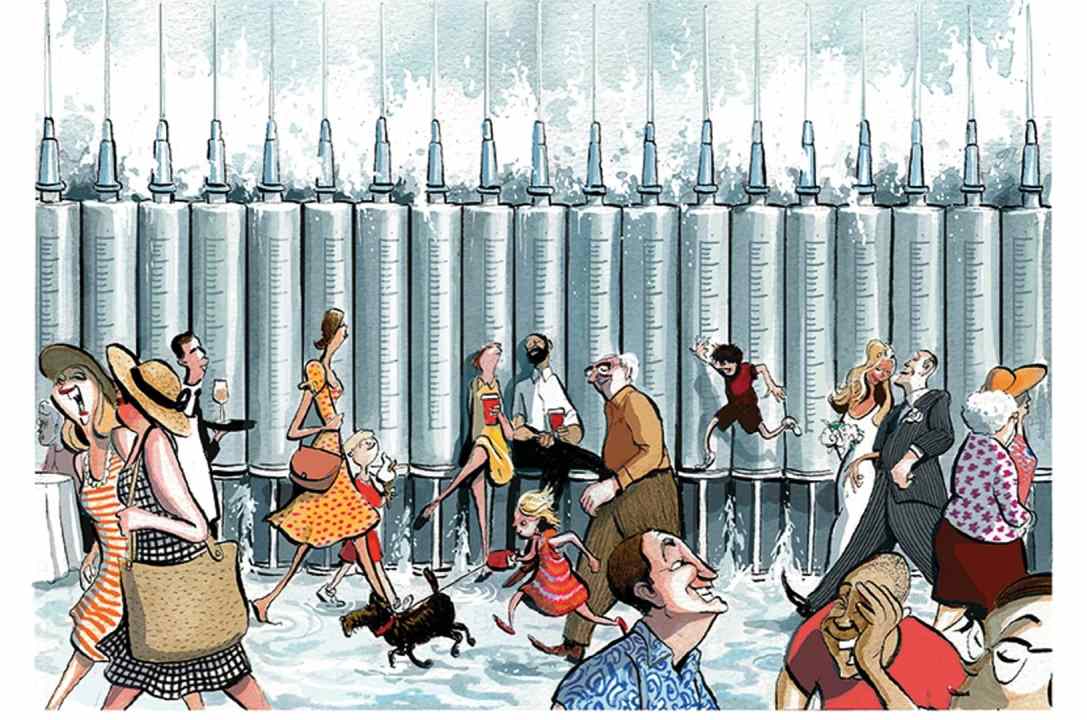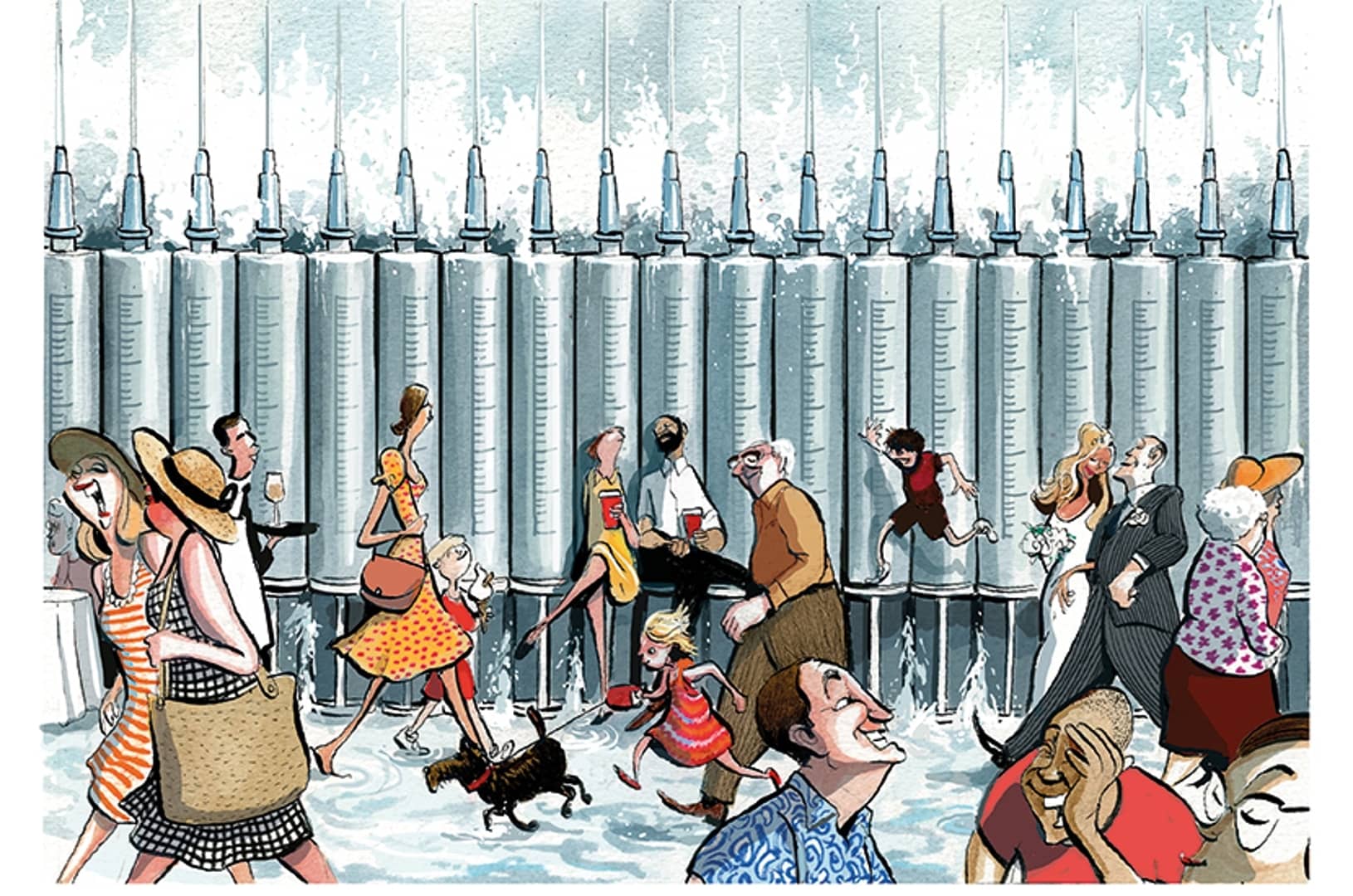The third wave of Covid-19 may now be no more deadly than a typical wave of influenza (thanks to vaccines) but be in no doubt: the rise in cases is real, likely to continue for some time and may dwarf the second wave. It may still be safe to unlock against this backdrop, but this (very different) scenario would need properly explained, with self-isolation rules rewritten. The facts have changed, but the argument has not (yet) changed.
We’ve been tracking the emergence of the India/Delta variant on The Spectator’s data hub. The below is a summary of the likely direction of travel. It has taken the UK from having the lowest Covid case levels in Europe to having the highest in just a few weeks – with much more still to come.
Cases may not cause serious illness, but they will cause serious disruption – given the NHS policy of asking everyone’s contacts to self-isolate (even if they are double-jabbed or have recovery immunity). SAGE documents released last week show scenarios for hospitalisation rates. Given the figures that SAGE has come up with previously (most notoriously its 4,000-deaths-a-day figure on the 31 October press conference) you might be forgiven for disregarding its analysis. But they also match Bristol Uni’s PCCF project which we at The Spectator have found to be more reliable: it currently predicts hospitalisations peak at just over 900 on 20 August.
All this makes it a lot harder to dismiss the idea of a third wave as SAGE spin. The Bristol model reckons 85pc of adults in England have detectable antibodies, with just two-thirds of whole population (ie, including kids) immune. It assumes Indian variant is infectious enough work its way through everyone who remains susceptible, even if they end up with nothing more than a runny nose. The good news is that this will, at least, rule out a winter wave: by September there will be almost nobody left to infect.
Importantly, no scenarios points to the NHS being overwhelmed. At most, Covid patients would occupy 2.5pc of hospital beds (at the last count, 8pc of beds lay unoccupied). The traditional test for lockdown – fear of a health service not being able to cope – is not met under any scenario.
The Delta variant means the UK lockdown exit narrative will be very different to that to the US state of Vermont, for example, where all Covid restrictions are being lifted on account their high vaccine rate. Ours is higher, but Covid cases are dying out in Vermont whereas they are surging here faster than any European or G7 country. Put SAGE aside. Here is the Bristol Uni PCCF modelling, assuming the variant is 64 per cent more transmissible (PHE is going with 68pc).
As I argue in the last episode of SpectatorTV, the above chart raises an ominous scenario. Say we proceeded with 21 June reopening tomorrow, masks off, ‘freedom day’ etc. Restrictions end, back to work, back to football etc. Then a third wave hits, with millions ordered into self-isolation.Hospitals could easily cope. But under the current Dido Harding regime we’d see pubs shut because a waiter tested positive; entire classes of kids pinged and told to self-isolate, offices closed – and, and far as we can work out, on a scale larger than anything we seen so far. There would be anger, confusion – and no shortage of people willing to blame the 21 June unlocking. This would risk panic, damaging the confidence needed to rebuild the economy and society. It would have been a self-defeating liberalisation.
Explaining the exit wave narrative: this time, it’s different
Another way is needed. The first thing ministers will have to explain is vaccine efficacy, below. This is the news that Matt Hancock now stands accused of concealing from the Prime Minister: one jab of Pfizer is 94pc effective on the variant, rising only marginally to 96pc on the second dose. With Astra, the difference is bigger: 71pc and 92pc. So on this study, Pfizer is shown to more effective on the Indian variant (with one jab) than the previously-dominant Kent variant.
The next point to make is that cases no longer translate into hospitalisations in the way they once did. Last week’s SAGE analysis calculated a ratio of hospitalisations to cases, assuming a ten-day lag. We have replicated its methodology and extended the graph: the below shows hospitalisations falling with a ratio half of what it was in the first three months of this year.
Lower hospitalisation numbers reflect the far-lower age of those getting infected. The daily totals – which are trotted out on television news without context – can be deeply misleading because infections amongst the old are very different to those amongst the young. The UK Covid stats have a five-day delay on the age breakdown, but it shows how few of them are currently over-65s (at the time of writing, just 5pc).
If we unlock this summer, a big third wave will get underway: it has started now and will become much bigger in days ahead. But it will be the least deadly of all the waves, and may well pose no more risk than a standard wave of flu. Covid has now been permanently downgraded as a threat by the vaccines. There is a case to be made to get through this, not to fear the high case numbers as we once did.
But saying ‘face the third wave with vaccines and confidence’ is a different message to saying “let’s sound the all-clear.” The Indian variant means a very different message is needed for reopening: one that simply was not ready two weeks ago. Ministers should start working on one now. As I argued in my Daily Telegraph column of 11 March, “after lockdown we can expect a third wave – and No 10 needs to admit it.”
PS One final graph: prevalence of the Indian variant worldwide.








Comments